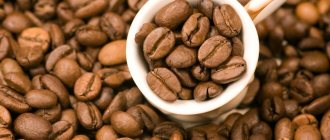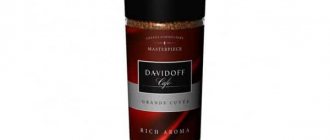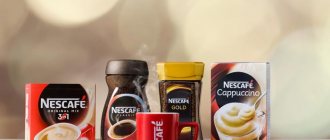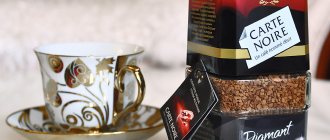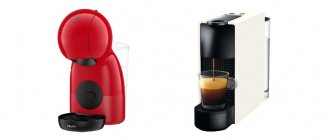Home » Ratings » Product ratings » Ground coffee rating » Ground coffee rating for cappuccino
* The selection/review was compiled according to the opinion of the editors of www.gidpokuhne.ru. About the selection criteria. This material is subjective in nature, does not constitute advertising and does not serve as a purchase guide. Before purchasing, consultation with a specialist is required.
Updated:
14.02.2022
Rating 2021-2022 of the best ground coffee for cappuccino according to customer reviews: which ground coffee is better to buy, how to choose the right one, price comparison, buy in a reliable online store in your city.
How to distinguish between recipes?
The ingredients commonly used to make both drinks are similar. Usually this is coffee with milk, toppings to taste and sugar. The recipes are just a little different.
The main difference between a latte and a cappuccino is the very proportions of milk, coffee and delicious milk foam.
Let's look at both recipes. First of all, let's look at the ingredients.
Latte
- To prepare this drink, take one fourth of espresso.
- Add three-fifths of milk. If the latte is prepared with cream, then you will need to take half the cream.
- One-fifth of the milk foam also goes into the drink.
Classic cappuccino
- In this case, you need to take one third of the milk.
- The same amount of espresso.
- And the same amount of milk foam.
What follows from this? There is much more espresso in a cappuccino than in a latte, so this recipe is closer to coffee, but a latte is considered a coffee cocktail.
But what is the difference between a latte and a cappuccino during the preparation process? These drinks are generally not made in the same sequence.
Preparing cappuccino
- To begin, pour a shot of espresso into the cup.
- Then add milk, which must first be whipped.
- Spread foam on top.
- The drink should not be stirred.
When it comes to latte, it can be made in two different ways.
Making a classic latte
It is prepared according to the same principle as cappuccino, except the proportions are different.
There is also one variety of this drink. It's called a latte macchiato. So what is the difference between a cappuccino and a latte macchiato?
- To prepare this drink, milk or a mixture of cream and milk is heated.
- Then espresso is added.
- The foam is added either at the end or before the coffee needs to be poured.
As a rule, lattes were not stirred in the past in order to maintain the layered structure. At the moment, a homogeneous drink is especially popular, which is why it is allowed to be mixed.
History of coffee
And it all started... with a goat. More precisely, from goats. The most ordinary goats, whose instinct told them that if they eat fruits from a certain tree, then they have more strength and can jump higher. And then it was up to the observation of the Ethiopian shepherds, who also decided to try these fruits by mixing them with animal fat. At first they were popular among nomads, who were given strength on long journeys.
Then Sufi monks began to drink a drink made from coffee beans. And already in the 15th century, along with the spread of Islam throughout the eastern countries, it became known everywhere and quickly gained popularity. The ban on alcohol adopted among Muslims played a significant role in this. Coffee acted as an alternative to wine, since it was not prohibited by religion, and its tonic effect on the body became an excellent substitute for getting drunk.
Gradually, from the countries of the East, coffee spread throughout the world. This process was inevitable, despite the strict bans on the export of grains to other countries that existed at that time, since its popularity attracted the attention of everyone, including smugglers. It was thanks to them that plantations appeared first in India, then in Suriname, Guyana, Brazil...
Coffee shops began to open in European countries and the United States, which instantly gained popularity among the population. Coffee turnover in total world trade is currently in second place after oil.
Interesting Facts
Over the centuries, this drink has been extensively studied by both doctors and scientists from other branches of science, and they have collected many interesting facts about it:
- caffeine in small doses is beneficial, in large doses it is harmful, and to consume it in a lethal dose, you need to drink about 100 cups;
- To achieve an optimal tonic effect, a healthy adult needs about 500 mg of natural coffee per day;
- The most caffeine is in light roasted beans, especially if it is Robusta, in which its content is 2%, twice as much as in Arabica;
- The amount of caffeine can be easily determined by taste: the more bitter it is, the more it will invigorate, too much of it can cause hallucinations, but in small quantities it can provide additional benefits by enhancing the effect of a number of painkillers on the body (paracetamol, aspirin, etc.) .);
- It is better to brew coffee in water, the temperature of which is very close to boiling - 95-98 degrees, but not in boiling water;
- The shelf life of unroasted beans is about a year; after roasting, they begin to lose their positive qualities within two days;
- depending on the variety, the number of aromatic compounds can reach 800, various antioxidants – 300, and the number of different chemical compounds and substances can exceed 1200 species;
- drinking coffee promotes rapid fat burning during intense physical activity (and therefore, when drinking more than 5 cups, athletes may have problems with the International Olympic Committee regarding doping), and coffee itself (without additives in the form of milk, sugar, etc.) has no calories at all does not contain;
- Initially, only natural coffee existed, and instant coffee was the contribution of Europeans; it was invented by a native of Belgium, George Washington, in 1906;
- The country with the record for consumption is Finland, with 12 kg of grains per year per inhabitant.
The cost of coffee varies greatly. The most expensive and exotic is considered to be kopi luwak, made from grains obtained in an original way: they are taken from the excrement of the palm marten - musang, washed and dried. It is not known who and when came up with this method of preparation, but currently it is considered the most exquisite, and its price reaches $1,200 per kilogram.
What is the difference between milk foam in lattes and cappuccinos?
If we consider the foam of both coffee drinks, then the cappuccino is denser. As a rule, the sugar or cinnamon that is usually sprinkled on top does not settle to the bottom. Also, the layer of foam itself is always large.
Latte foam is usually loose, and its layer in the glass is not very high. As a rule, it should be considered as a decoration rather than a flavor component. Why is this happening? During the preparation process, the cappuccino foam takes a little longer to whip up. Also in this case, they even use milk with a higher fat content. But more about this in the next section.
Which milk should you choose for lattes and cappuccinos?
As a rule, the choice of milk often affects the taste of both drinks. In particular, you should pay attention to the amount of proteins. Fat content does not play a special role. You should also adhere to certain proportions:
- If there is a lot of milk, the foam will be thick.
- If this ingredient is not enough, the foam will turn out dry and airy.
The thickest foam can be obtained from pasteurized milk. As a rule, to obtain the foam itself, a special milk frother or a steam wand of an espresso machine is used. How does this process happen? The device blows steam into the milk, then the milk is heated, and after that it is saturated with air. It’s just that in one case there are more bubbles, and in the other there are fewer bubbles. Experienced baristas use protein percentages ranging from 8 to 3.8%.
Calorie content in kcal in a mug of black coffee with and without additives
Coffee beans contain sugars and fats, as well as some protein, and if the roast is fresh enough, this will only increase the calorie content. For example, freshly roasted and ground coffee beans without added sugar can provide an increase of 0.5-1 kcal per 200 ml (mug of drink).
The situation with sugar is somewhat different. It all comes down to portions. A teaspoon without a slide accounts for 18-20 kcal, with a larger teaspoon - 26-28 kcal. If you want to add spices to your coffee, keep in mind that even 1 g gives an increase in calorie content:
- dry ginger – 1 kcal/1 g;
- cinnamon – 2.5 kcal/1 g;
- vanilla – 3 kcal/1 g;
- cardamom – 3 kcal/1 g;
- cloves – 3 kcal/1 g;
- pieces of fresh ginger – 3.5 kcal/1 g;
- nutmeg – 5 kcal/1 g.
How to serve drinks?
Surely each of you has noticed that if you order a latte or cappuccino in a cafe, then the methods of serving this or that drink are always different. Cappuccino is usually served in small cups, usually with a volume of 220 ml. As for the walls of such a cup, they must be smooth. This is necessary to ensure that the foam is dense and stable.
Latte, on the contrary, is served in tall glass or ceramic glasses. If we consider a serving, it usually ranges from 250 to 360 ml. Glasses usually expand at the top. The temperature of the drink is 60–70 degrees. This also applies to cappuccino. Usually, frothed milk that is poured into a cup forms beautiful patterns. This technique is called latte art.
How should you drink coffee drinks correctly?
Italians advise drinking lattes and cappuccinos exclusively before twelve o'clock in the afternoon. They are considered morning drinks due to the coffee and milk content. In Russia, such restrictions do not exist, and drinks can be enjoyed at any time of the day.
Since cappuccino contains a lot of caffeine, it complements a light snack or even lunch. As a rule, it must be drunk through a straw. Italians do not recommend stirring cappuccino. They consider it bad manners. You shouldn’t even put sugar in this drink, otherwise the taste won’t fully develop. It is known that desserts such as panna cotta, brownie or even coconut cookies will be combined with cappuccino. Strawberry jelly or meringue would also work.
Now let's look at the best way to drink a latte. The volume of this drink is large, so it will be ideal for drinking between meals.
Since there is not much caffeine in a latte, you can drink it even in the evening. For example, as a soft drink. You can also read about how many calories a latte contains.
Usually, a napkin, straw and spoon are served along with the drink itself. This means that the drink can be stirred. A napkin is required so that no one burns their fingers while mixing. Like cappuccino, latte is drunk through a straw. A particularly tasty combination would be latte and various soufflés, cheesecakes and mousses. You can also drink this drink with chocolate ice cream or even marshmallows. Raspberry sorbet or strawberry pudding would also be good.
The nutritional value
Nutritional value refers to the ratio of BJU of the product. For a balanced classic latte it's:
- 25.5% proteins;
- 27.6% fat;
- 46.9% carbohydrates.
Considering that the drink mostly consists of water, the content of nutritional components in it is small - approximately 2.16 g of protein and 1.35 g of fat, and the mass of carbohydrates is variable - in terms of sweetness.
The calorie content of coffee latte per 100 grams depends on its type, additives and milk fat content. Sugary and decorated coffee, be it cappuccino, macchiato or latte, is significantly higher in calories. To keep your figure and your glucose levels normal, give up sweet recipes and drink your favorite drink almost without restrictions.
What do lattes and cappuccinos taste like?
If you try cappuccino, it tastes too coffeey. Milk can only emphasize the unique aroma of espresso. Without sugar, this drink has some nutty notes. The taste of the foam is milky, and the top is often sprinkled with cinnamon, cocoa and chocolate.
The latte tastes delicate, creamy and milky. It is also not as strong as cappuccino. If you don’t add sugar to the drink, it will seem almost milky. That is why the taste of coffee does not play a particularly important role here. Even from Italian “latte” is translated as milk. The foam of this drink is light and has a delicate milky taste.
Thus, although both drinks seem almost identical, if you look closely and taste, you can always find differences.
Historical information
The first mentions of latte can be found in the works of American writers of the mid-19th century. For example, William D. Howells, in his book called Italian Travels, talks about it. At this time, latte appeared in Italian coffee shops, where it was prepared specifically for visitors who preferred drinks that were less strong in taste.
Latte became widespread in the 80s. XIX century in America, where a local barista offered his cappuccino-based aperitif recipe. He simply added milk to strong coffee, calling it caffe latte.
Cappuccino is purely Italian in origin. It was created in the 18th century. monks of the Capuchin order, hence its name. Even the external design of the drink was reminiscent of the brothers' tonsure: the light component symbolized the bald top of the head, the dark component symbolized the edge of the hair around it.
The initial recipe for the drink consisted of beaten egg yolks, strong brewed coffee and cream. A little later, Padre Carlo improved the technology. He invented the world's first cappuccino machine. In one compartment, water was heated until steam was formed, which flowed through a tube into the other compartment. The milk itself was already foaming there. Coffee makers still work on this principle.
Drinks became commercially available at the beginning of the 20th century. with the invention of the espresso machine. Their preparation has become much simpler, and aperitifs have become a mandatory item on the menu of every cafe.

